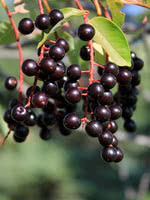Mon-Fri 9am - 5pm Mountain time
Western Chokecherry vs Wayfaring Tree
Prunus virginiana var. demissa
Viburnum lantana
SOLD OUT
CUSTOM GROW
Western Chokecherry is a shrub or small tree commonly used for farmstead and field windbreaks.
It produces white flowers in the spring and edible dark purple fruit that matures between September and October. Its cherries are great for making for making jams, jellies or wine, but are not very palatable for raw eating.
Wayfaring Tree is an adaptable and reliable shrub. It is prized for its ornamental berries that can range in color from red to yellow to black. Consider getting two trees as fruiting is maximized when another Wayfaring Tree is present.
This species has a variety of uses ranging from naturalization, mass planting, borders, and privacy screens.
Western Chokecherry Quick Facts
Wayfaring Tree Quick Facts
Toxicity: toxic to horses, cattle, etc.)

